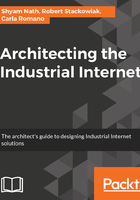
Computational deployment patterns
The Industrial Internet encompasses many topologies of assets, and sensor and computational distributions. Traditional control systems typically disperse computational power close to the physical systems, in the network periphery, and are performed at the controller level. Traditional data centers perform centralized computations. The Industrial Internet requires a combination of both of these. Smart sensors and devices perform dispersed computations to enable localized control and decision making, while concentrated computation placed throughout the network supports higher-level decision making.
Network connectivity is critical for communication between the periphery and the concentrated capabilities. Concentrated computational capabilities enable a wider and deeper spectrum of analytics using data integrated throughout the industrial system, including traditional applications data.
The placement of computational capabilities in relation to the periphery requires architectural choices to be made. If the assets are high in number and widely dispersed to remote areas, a strong peripheral computation capacity is necessary, especially if latency, local control, and resilience are critical. Functions performing higher-level computations that incorporate data from multiple systems, but do not depend on strict latency requirements, can be performed by a concentrated computational capability. Generally, IIoT systems use a combination of peripheral and concentrated computational patterns. Distributed computational concentration is most resilient, while concentrated computation has the potential for more robust analytics.